BAKER’s Dozen
“Warfare, perhaps civilization itself, has been brought to a turning point by this revolutionary weapon.”
– Vice Admiral W. H. P. Blandy, USN, Commander of Operation CROSSROADS
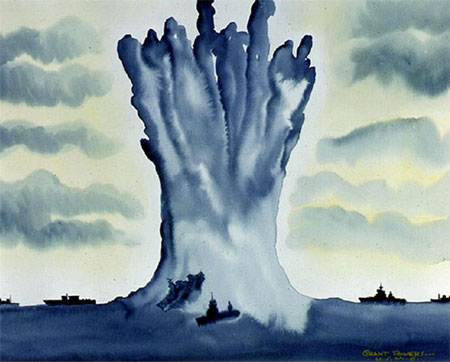
(Combat Artist Grant Powers painted this striking image of USS Arkansas starting to go vertical into the BAKER water column. We watched in amazement from USS Mount McKinley (AGC-7), Flagship of Operation CROSSROADS underway. Photo Navy Historical and Heritage Command).
After we abandoned ship just as we had for the ABLE shot to get a safe distance from the coming atomic explosion. The pirate American crew was dispersed among the dozens of support ships. A dozen of us found ourselves on RADM Blandy’s Joint Task Force ONE flagship, Mount McKinley (AGC-7), which was anchored about a dozen miles away from the target ships in the lagoon.
We jokingly called ourselves the BAKER’S DOZEN, since we expected to return to the mighty ex-IJN battleship Nagato once the test was complete. We would then try to clean the ship up from any fallout and begin preparations for the third in the series, blast CHARLIE. That one was planned to demonstrate the properties of an atomic explosion in deep water.
As it turns out, it did not happen that way, and like Test ABLE, there was a SNAFU that changed everything.
We rose early on the morning of the 25th of July and got chow in the wardroom before venturing out on deck to find a good perch to watch the test. We marveled at the VIP guests who were aboard to witness the event.
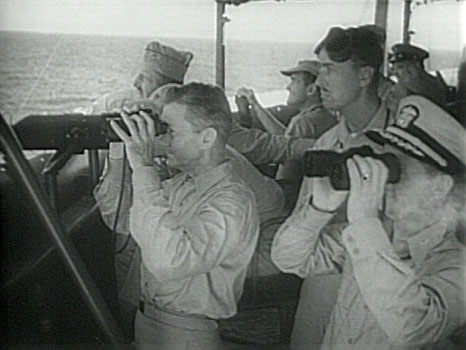
SECNAV James Forrestal himself was there, in plain unadorned khakis, along with congressmen and other Washington people interested in the new atomic technology. CROSSROADS was anything but secret, as opposed to the Manhattan Project that gave birth to the Bomb. These tests were intended to publicly demonstrate the might of this new technology to the world, and it certainly did that.
We were told that shot BAKER was expected to cause more damage to the target fleet than ABLE because it was an underwater detonation and closer to the surface. It was also expected to produce more radioactive contamination in Bikini Lagoon, although no one knew how much more. As it turned out, contamination from BAKER caused major problems that persisted for months and threatened the overall success of the entire CROSSROADS operation.
Pre-shot procedures were essentially the same as for ABLE: 68 target ships were moored in the lagoon and 24 small craft were beached on Bikini; all personnel were evacuated to the support fleet, which retreated upwind; and VIP observers and the press awaited the shot.
There was one important difference from the first test. This time we were encouraged to watch it directly. The scientists told us that since the blast was going to be at a depth of ninety feet, there would be no fireball, so we needed no goggles or smoked glasses.
We were on deck, looking toward the low dark silhouette of LSM-60, the heavily modified landing ship that lowered the bomb below the surface of the lagoon. The minutes clicked by, and we were advised over the ship’s loudspeaker that preparations were complete and M-Hour would be at 0835. I checked my watch to best advantage and moved to the rail to get the best view I could.
The signal was broadcast to the mast over the landing ship as planned, and then things became very interesting.
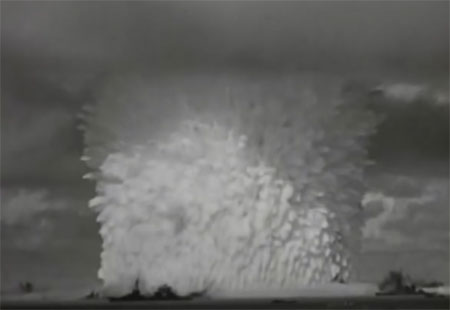
(An image of the initial water column, Nagato’s distinctive pagoda mast is seen at lower right. Photo USN).
The scientists told us later that the underwater fireball generated by the blast took the form of a rapidly expanding hot gas bubble, which reached down to the sea floor and up to the surface simultaneously. The result created a shallow crater on the seafloor 30 feet deep and nearly 2,000 feet wide. At the top, water burst through the surface like a geyser, creating a massive “spray dome” containing nearly two million tons of highly radioactive seawater.
What we saw was a thing that resembled an angry cauliflower in rapid motion. The expanding dome stretched into a hollow chimney of spray called the “column,” 6000 feet tall and 2000 feet wide, with walls 300 feet thick.
I could see Nagato’s distinctive profile at the base of the column, and then it was obscured as the space vacated by the rising gas bubble caused a tsunami nearly a hundred feet tall. In some of the pictures the CROSSROADS historian published you can see Nagato completely immersed in it, though the old girl held her own and stayed afloat.
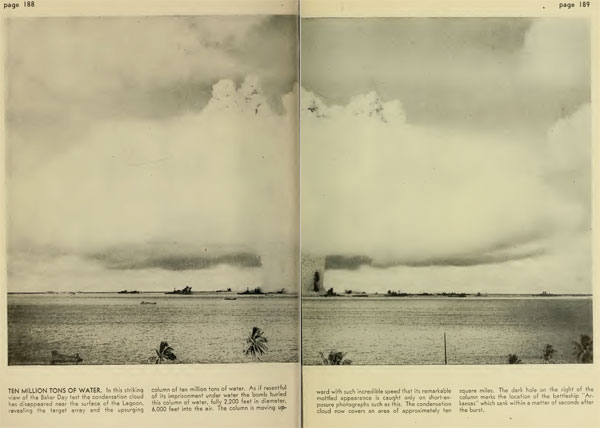
In one of the images I have in my copy of the pictorial history (H.M. Wise Co., 1946), there is a two-page depiction that includes a dark vertical shape at the base of the cauliflower. That was the USS Arkansas (BB-33), closest ship to the epicenter. The raw power of the BAKER device upended the 27,000-ton ship, thrusting its 562-feet hull stern first straight up in the air and then plunging the bow into the bottom of the lagoon before it toppled over backward into the water curtain of the spray column.
By the time the wave reached Bikini Island beach 3.5 miles away, a series of nine 15-foot waves tossed landing craft onto the strand and filled them with sand. Ten seconds after the detonation, falling water from the column created a 900-foot “base surge” which rolled over Nagato and the others, coating them with radioactivity so thoroughly that they could never be decontaminated. That was the SNAFU, maybe bigger than the one that landed the ABLE bomb so far off its intended target.
BAKER inflicted heavy damage on the target fleet. Eight ships, including the gallant aircraft carrier Saratoga (CV-3), were sunk; eight more were seriously damaged. Even more important for the remainder of the operation, the detonation caused most of the target fleet to be bathed in radioactive water spray and debris from the material dredged from the bottom of the lagoon.
The water in the lagoon near surface zero was intensely radioactive for several days as Admiral Blandy conferred with the scientists and tried to figure out what to do.
One thing I can say with certainty is that BAKER was the most impressive thing I have ever seen. A battleship thrown right into the sky like a toy! I took a certain amount of pride that our ship- Japanese though she might have been- was riding just fine at her anchorage. She was just deadly hot.
I was glad that I had dragged my full seabag along with me this time. We would not be going back aboard, or removing anything from her now. She was hot.
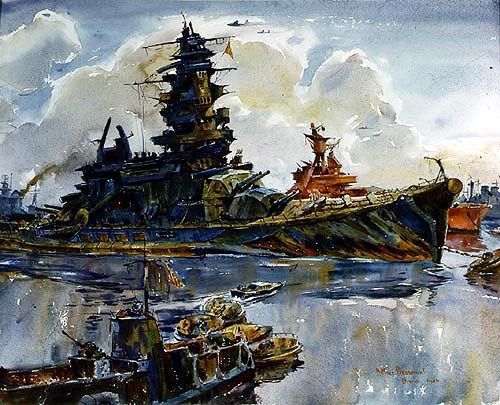
(ex-IJN Nagato after the BAKER blast. She is taking on some water, but we could not return to pump her out. Combat art by Art Beaumont. Image Navy historical and Heritage Command).
Copyright 2015 Vic Socotra
www.vicsocotra.com
Twitter: @jayare303
